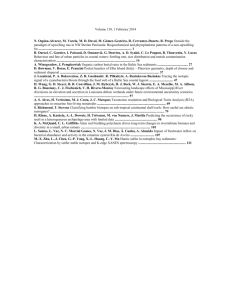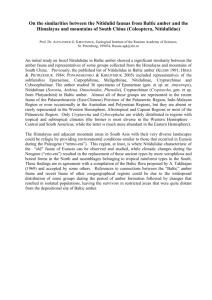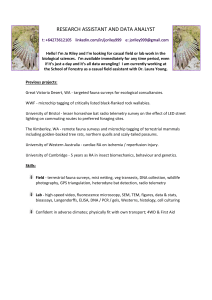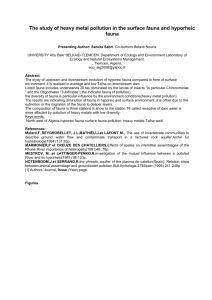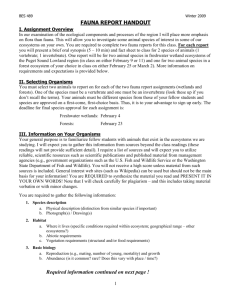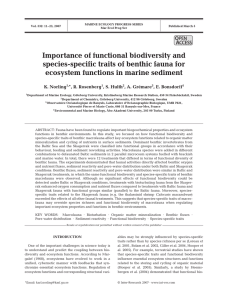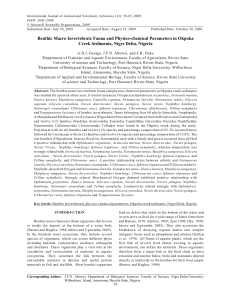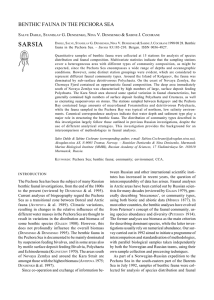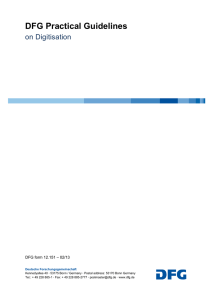NORTHERN ADRIATIC SEA "TEGNÙE" (OUTCROPS): DISTRIBUTION OF BENTHIC COMMUNITIES ON... STUDY SITES.
advertisement
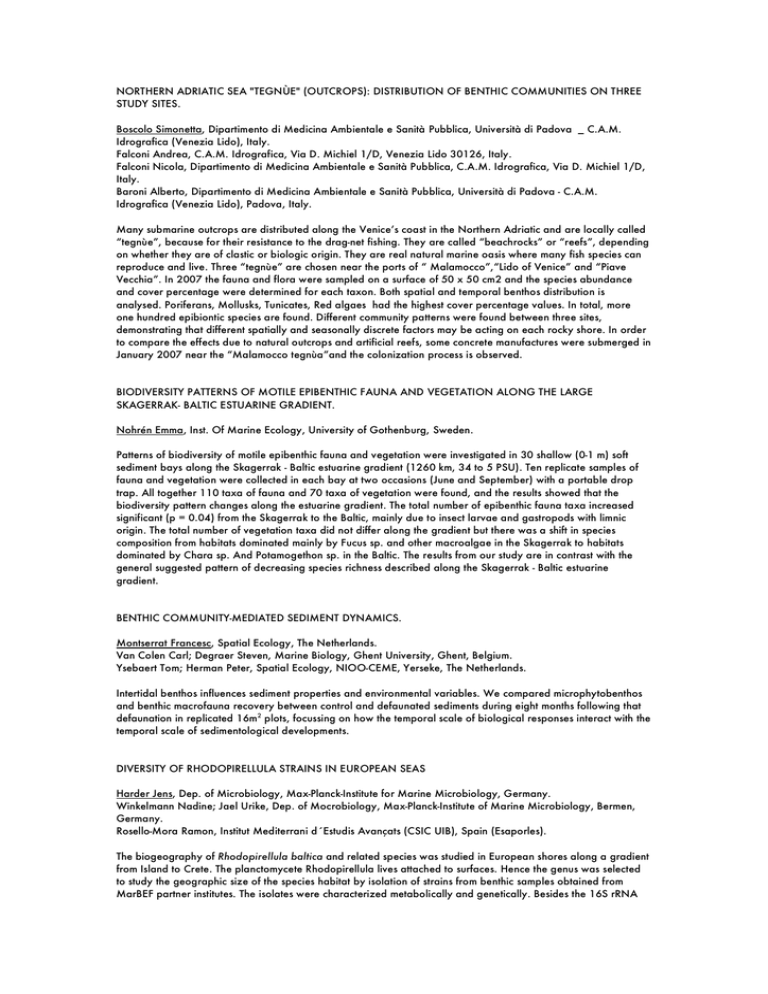
NORTHERN ADRIATIC SEA "TEGNÙE" (OUTCROPS): DISTRIBUTION OF BENTHIC COMMUNITIES ON THREE STUDY SITES. Boscolo Simonetta, Dipartimento di Medicina Ambientale e Sanità Pubblica, Università di Padova _ C.A.M. Idrografica (Venezia Lido), Italy. Falconi Andrea, C.A.M. Idrografica, Via D. Michiel 1/D, Venezia Lido 30126, Italy. Falconi Nicola, Dipartimento di Medicina Ambientale e Sanità Pubblica, C.A.M. Idrografica, Via D. Michiel 1/D, Italy. Baroni Alberto, Dipartimento di Medicina Ambientale e Sanità Pubblica, Università di Padova - C.A.M. Idrografica (Venezia Lido), Padova, Italy. Many submarine outcrops are distributed along the Venice’s coast in the Northern Adriatic and are locally called “tegnùe”, because for their resistance to the drag-net fishing. They are called “beachrocks” or “reefs”, depending on whether they are of clastic or biologic origin. They are real natural marine oasis where many fish species can reproduce and live. Three “tegnùe” are chosen near the ports of “ Malamocco”,“Lido of Venice” and “Piave Vecchia”. In 2007 the fauna and flora were sampled on a surface of 50 x 50 cm2 and the species abundance and cover percentage were determined for each taxon. Both spatial and temporal benthos distribution is analysed. Poriferans, Mollusks, Tunicates, Red algaes had the highest cover percentage values. In total, more one hundred epibiontic species are found. Different community patterns were found between three sites, demonstrating that different spatially and seasonally discrete factors may be acting on each rocky shore. In order to compare the effects due to natural outcrops and artificial reefs, some concrete manufactures were submerged in January 2007 near the “Malamocco tegnùa”and the colonization process is observed. BIODIVERSITY PATTERNS OF MOTILE EPIBENTHIC FAUNA AND VEGETATION ALONG THE LARGE SKAGERRAK- BALTIC ESTUARINE GRADIENT. Nohrén Emma, Inst. Of Marine Ecology, University of Gothenburg, Sweden. Patterns of biodiversity of motile epibenthic fauna and vegetation were investigated in 30 shallow (0-1 m) soft sediment bays along the Skagerrak - Baltic estuarine gradient (1260 km, 34 to 5 PSU). Ten replicate samples of fauna and vegetation were collected in each bay at two occasions (June and September) with a portable drop trap. All together 110 taxa of fauna and 70 taxa of vegetation were found, and the results showed that the biodiversity pattern changes along the estuarine gradient. The total number of epibenthic fauna taxa increased significant (p = 0.04) from the Skagerrak to the Baltic, mainly due to insect larvae and gastropods with limnic origin. The total number of vegetation taxa did not differ along the gradient but there was a shift in species composition from habitats dominated mainly by Fucus sp. and other macroalgae in the Skagerrak to habitats dominated by Chara sp. And Potamogethon sp. in the Baltic. The results from our study are in contrast with the general suggested pattern of decreasing species richness described along the Skagerrak - Baltic estuarine gradient. BENTHIC COMMUNITY-MEDIATED SEDIMENT DYNAMICS. Montserrat Francesc, Spatial Ecology, The Netherlands. Van Colen Carl; Degraer Steven, Marine Biology, Ghent University, Ghent, Belgium. Ysebaert Tom; Herman Peter, Spatial Ecology, NIOO-CEME, Yerseke, The Netherlands. Intertidal benthos influences sediment properties and environmental variables. We compared microphytobenthos and benthic macrofauna recovery between control and defaunated sediments during eight months following that defaunation in replicated 16m2 plots, focussing on how the temporal scale of biological responses interact with the temporal scale of sedimentological developments. DIVERSITY OF RHODOPIRELLULA STRAINS IN EUROPEAN SEAS Harder Jens, Dep. of Microbiology, Max-Planck-Institute for Marine Microbiology, Germany. Winkelmann Nadine; Jael Urike, Dep. of Mocrobiology, Max-Planck-Institute of Marine Microbiology, Bermen, Germany. Rosello-Mora Ramon, Institut Mediterrani d´Estudis Avançats (CSIC UIB), Spain (Esaporles). The biogeography of Rhodopirellula baltica and related species was studied in European shores along a gradient from Island to Crete. The planctomycete Rhodopirellula lives attached to surfaces. Hence the genus was selected to study the geographic size of the species habitat by isolation of strains from benthic samples obtained from MarBEF partner institutes. The isolates were characterized metabolically and genetically. Besides the 16S rRNA
